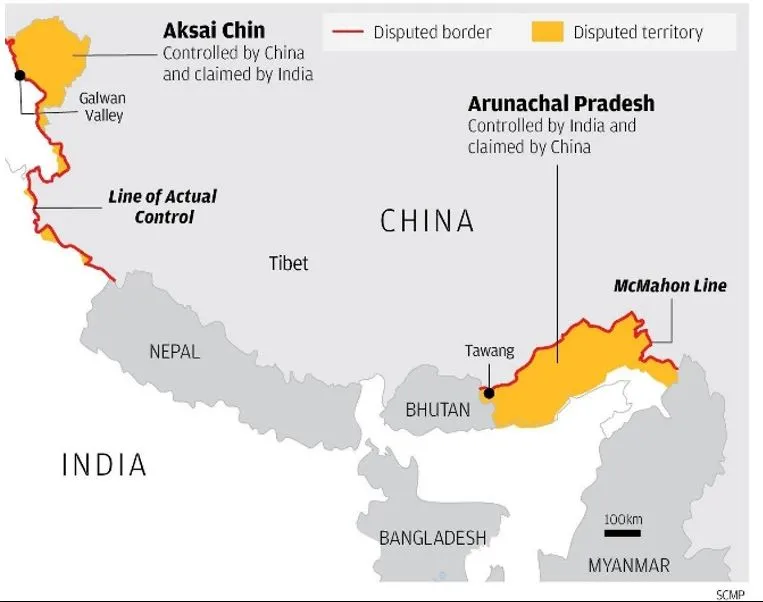

16th May 2025 (15 Topics)
Mains Issues
Context
India’s Defence Minister expressed strong concerns about Pakistan’s repeated threats of using nuclear weapons in response to India's actions. He questioned whether such weapons were safe in the hands of what he called a "rogue and irresponsible" state. He further stated that: “Pakistan’s nuclear weapons should be placed under the supervision of the International Atomic Energy Agency (IAEA).”
What is the IAEA and why is it relevant here?
- Created in: 1957
- Headquartered at: Vienna, Austria (UN Office)
- The International Atomic Energy Agency (IAEA) is a UN-affiliated body based in Vienna.
- Widely known as the world’s “Atoms for Peace and Development” organization within the United Nations family, the IAEA is the international centre for cooperation in the nuclear field.
- India is a founding member of IAEA.
- IAEA reports to both the UNGA and the UNSC.
- It supervises civilian nuclear programs to ensure they are not diverted for military purposes.
- IAEA is not normally involved in monitoring a nation’s military nuclear arsenal unless that nation voluntarily allows it.
- So, placing nuclear weapons under IAEA control, would mean:
- Pakistan should allow external inspection or control over its nuclear weapons.
- This would be a major loss of strategic autonomy for any nuclear-armed state.
- India is using this demand more as a moral and diplomatic argument than a legally enforceable action.
Why is this statement important now?
- Repeated Nuclear Threats by Pakistan: Pakistan (leaders or media) have often invoked nuclear weapons as a deterrent whenever India conducts military operations. This has been labeled by Indian leadership as “nuclear blackmail.”
- Recent Signals from Pakistan: After India’s Operation Sindoor, Pakistan’s military reportedly signaled that its National Command Authority (NCA) — the body overseeing its nuclear arsenal — might convene.
- India’s Strategic Messaging: By questioning the safety of Pakistan’s nuclear weapons, India is:
- Highlighting global concerns about proliferation risks.
- Countering Pakistan’s nuclear bluff with bold diplomatic statements.
- Attempting to shift the burden of escalation onto Pakistan.
- It is part of a wider strategic communication from India:
- To discredit Pakistan’s nuclear threats.
- To garner international sympathy and isolate Pakistan diplomatically.
- To legitimize India's military responses as justified and restrained in the face of provocation.
PYQQ. In India, why are some nuclear reactors kept under “IAEA safeguards” while others are not? (2020)
Solution: (b) Q. In the Indian context, what is the implication of ratifying the ‘Additional Protocol’ with the ‘International Atomic Energy Agency (IAEA)’? (2018)
Solution: (a) |


Mains Issues
Context
President Droupadi Murmu has invoked Article 143 of the Constitution to seek the Supreme Court’s advisory opinion on 14 constitutional questions. This move follows a landmark judgment of the Supreme Court that imposed timelines on the President and Governors for deciding on state bills—a ruling that has triggered significant constitutional debate.
Brief Background:
- In recent years, several state governments have accused Governors of delaying or obstructing the assent to bills passed by their legislatures. One prominent instance involved the Tamil Nadu Governor withholding assent to 10 bills passed by the state assembly.
- In April 2024, a two-judge bench of the Supreme Court ruled that Governors and the President must act within defined timelines when dealing with bills:
- A Governor must give assent, withhold assent, or reserve the bill for the President’s consideration within three months.
- If a state re-enacts an identical bill, the Governor must act within a month.
- The President must decide within three months on a bill reserved by the Governor.
- The Court also held that in certain cases, assent would be deemed to have been given—a concept not explicitly mentioned in the Constitution.
- This prompted the President to seek clarity from the Supreme Court through a Presidential reference, as the judgment raised concerns about its alignment with constitutional provisions.
What is a Presidential Reference (Article 143)?
- Article 143 empowers the President to refer questions of law or fact to the Supreme Court for its advisory opinion.
- This is not a judicial proceeding but a constitutional consultation.
- The President may seek advice:
- (1) If it is of public importance or involves substantial questions of law, especially on constitutional interpretation.
- (2) After the enactment of any law, to understand its constitutional validity.
- The Supreme Court’s opinion under Article 143 is not binding on the President, but it holds persuasive value and is considered with great respect.
- The President has raised 14 important constitutional questions, indicating that the SC judgment has raised legal uncertainties, particularly because:
- The Constitution does not mention specific timelines for Governors or the President to act on bills.
- The SC’s direction to “deem assent” is being questioned as it may curtail constitutional discretion.
- There’s ambiguity over judicial review of decisions made by the President and Governors, who enjoy constitutional protections.
- Federal balance, judicial activism, and constitutional interpretation are under scrutiny.
Key-Constitutional Provisions Involved
|
Article |
Subject |
|
Article 200 |
Powers of the Governor on state bills: assent, withhold, return, or reserve for the President |
|
Article 201 |
When a Governor reserves a bill, the President can either assent or withhold. |
|
Article 143 |
President can seek advisory opinion of the Supreme Court. |
|
Article 142 |
Supreme Court's power to pass any order necessary to do complete justice. |
|
Article 361 |
Immunity for President and Governor from legal proceedings. |
|
Article 131 |
Supreme Court’s exclusive jurisdiction over Centre-State disputes. |
|
Article 145(3) |
Requires a five-judge bench for cases involving substantial questions of constitutional interpretation. |
Judiciary and Executive
- At the heart of this controversy lies the balance of power between the judiciary and the executive in interpreting and exercising constitutional discretion—particularly the role of the President and Governors in the legislative process.
- The key issues include:
- Whether timelines for granting assent can be judicially imposed when the Constitution does not explicitly mention them.
- Whether the concept of “deemed assent”, introduced by the Court, is constitutionally valid.
- The scope of judicial review over the discretionary powers of constitutional authorities like the President and Governors under Articles 200 and 201.
- The limits of judicial intervention under Article 142, which gives the Supreme Court power to do "complete justice".
- The proper forum and bench size (minimum five judges) for deciding such substantive constitutional questions.
Constitutional Discretion VS Judicial Review
|
Constitutional Discretion |
Judicial Review |
|
|
- This raises the question: Can courts dictate how constitutional discretion should be exercised, especially when timelines are not mentioned in the Constitution?
- The presidential reference argues that this judicial activism may erode the discretion granted by the Constitution and disrupt the federal balance.
- On the other hand, the judiciary views inordinate delays in giving assent as subverting democratic processes and harming the will of the elected legislature.


Mains Issues
Context
India’s digital infrastructure, especially for identity verification like KYC, has become essential for accessing financial and government services. However, it remains largely inaccessible to persons with disabilities (PwDs), prompting the Supreme Court to reinterpret Article 21 to include the ‘right to digital access’.
What is Article 21?
- Article 21 says: “No person shall be deprived of his life or personal liberty except according to procedure established by law.”
- Over the decades, courts have expanded this to include rights such as:
- Right to dignity
- Right to education
- Right to shelter
- Right to health
- Now, the Supreme Court has added a new dimension—right to digital access—recognising that exclusion from the digital world can seriously affect a person’s right to live with dignity.
Legal Framework Supporting PwD Rights
- India has both constitutional and statutory protections for persons with disabilities:
- o Constitutional Mandate: The Preamble, Fundamental Rights (especially Articles 14, 15, 21), and Directive Principles guide the state to promote justice, equality, and dignity.
- o Rights of Persons with Disabilities (RPwD) Act, 2016: It aligns India with the UN Convention on the Rights of Persons with Disabilities (UNCRPD).
- It moves away from a purely medical model and adopts a social-barrier approach—disability is not just a bodily impairment, but also the result of barriers in society.
- Section 42 specifically mandates that electronic and print media be made accessible, with features like:
- Audio description
- Captions
- Sign language
- Universal design principles in electronic devices
Why KYC is a Barrier for PwDs?
- KYC (Know Your Customer) norms are legal requirements that every bank, telecom provider, insurance company, etc., must follow to verify identities. It’s meant to stop fraud and money laundering.
- However, the current digital KYC methods exclude many PwDs, especially the visually impaired and acid attack survivors:
- Facial Recognition & Selfies: Visually impaired persons or those with disfigurements cannot easily align their face for a selfie or complete facial verification.
- Visual Tests: Blinking, reading on-screen codes, or clicking on-screen prompts are not accessible.
- No Audio or Screen-Reader Support: KYC apps rarely support screen readers or provide voice-guided cues.
- Document Uploads: Users can’t distinguish document sides or check if their PAN/Aadhaar has uploaded correctly.
- No Valid Signature Alternatives: Thumb impressions, often used by visually impaired individuals, are not accepted. PAN cards can’t be issued with thumb impressions.
- OTP and Real-Time Verification: Expecting users to respond in 30 seconds with perfect camera positioning leaves out many disabled users.
- Despite ICT Accessibility Standards (2021, 2022) issued by the Ministry of Electronics and IT, most service providers have not complied.
Supreme Court Ruling
- In Rajive Raturi v. Union of India (2024) and the April 2025 KYC case, the Supreme Court:
- Declared digital accessibility a constitutional requirement, not a matter of policy choice.
- Anchored its decision in Articles 14 (equality), 15 (non-discrimination), 21 (life and liberty), and 38 (justice and welfare).
- Reaffirmed that digital exclusion is a form of digital discrimination that violates the dignity and equality of PwDs.
- Directed institutions like the RBI, SEBI, and DoT to revise digital KYC norms and ensure universal accessibility in all digital services.
- SC rightly pointed out that in a digital-first society, the denial of digital access is a denial of dignity, freedom, and opportunity.
Why this Judgment is a milestone?
- Recognition of Digital Exclusion as a Rights Violation: Digital platforms are the new gatekeepers to essential services. Excluding PwDs from them effectively means denying them participation in society.
- Article 21 (A Living, Evolving Right): This ruling builds upon earlier SC decisions where:
- Right to privacy (Puttaswamy case)
- Right to die with dignity (Common Cause case)
- Right to access COVID vaccines digitally (during pandemic)
- were read into Article 21. The right to digital access continues this progressive trend.
- Future Reforms: This case sets a precedent for:
- Inclusive digital governance
- Accessible fintech, edtech, and health platforms
- Private sector compliance with accessibility norms
Required Measures
- Enforceable Guidelines: RBI, SEBI, and DoT must revise their frameworks and issue binding directions to regulated entities.
- Universal Accessibility Audits: KYC apps, websites, and customer service platforms should be audited by accessibility experts.
- Inclusive Tech Design: Future fintech and government platforms must be designed with accessibility in mind from the start, not added later as an afterthought.
- Training and Awareness: Institutions must train staff and developers on accessibility laws and user needs.


Mains Issues
Context
A recent PIL has reignited the debate on whether NOTA (None of the Above) should be made a compulsory option in all elections, including those with only one candidate. This brings into focus deeper questions about voter choice, electoral legitimacy, and democratic accountability.
What is NOTA and when was it introduced in India?
- NOTA — ‘None of the Above’ — is an option on the Electronic Voting Machine (EVM) that allows a voter to formally reject all contesting candidates.
- It was introduced by the Election Commission of India (ECI) in 2013, following a Supreme Court ruling in a PIL filed by the People’s Union for Civil Liberties (PUCL).
- The court held that the right to vote includes the right not to vote, and that voters should be able to express disapproval of all candidates without compromising the secrecy of their ballot.
- However, while NOTA allows symbolic rejection, it currently carries no legal consequence — the candidate with the highest votes still wins, even if NOTA secures the most votes.
Why is there a demand to make NOTA compulsory in all elections?
- There are demands to make NOTA compulsory in all elections, including uncontested ones.
- In cases where only one candidate is contesting, voters are currently left with no real choice. If such an election proceeds without a NOTA option, voters cannot express dissatisfaction — effectively denying the spirit of electoral choice.
- Proponents argue that:
- It maintains democratic integrity by allowing dissent against uncontested candidates.
- It ensures that elections are more than a procedural formality.
- Even in rare cases, symbolic participation matters — especially in strengthening a culture of accountability.
- Thus, the PIL seeks to mandate NOTA in all elections, including single-candidate or uncontested elections.
What is Election Commission's stance?
- The Election Commission (EC) opposes the idea of making NOTA mandatory in every election, especially in uncontested ones, for several reasons:
- Rare Occurrence: EC says that uncontested elections are extremely rare — only 9 instances since 1952, and 6 in Lok Sabha elections since 1971. So, this issue is more symbolic than practical.
- Lack of Statutory Backing: Making NOTA mandatory would need amendments to the Representation of the People Act, 1951 and Conduct of Elections Rules, 1961, which only the Parliament can do, not the EC or courts.
- Limited Impact of NOTA: According to the EC, NOTA has not brought significant change in voter behaviour or candidate accountability — less than 1-2% of voters choose NOTA in most elections.
Is NOTA really insignificant?
- While NOTA may seem symbolically weak due to its lack of legal consequence, its democratic value is substantial, especially in the following ways:
- Expression of Dissent: NOTA gives space to express dissatisfaction without boycotting the election altogether.
- Silent Protest: It can be used by voters to protest against poor candidate quality, criminal backgrounds, or lack of choice.
- Data Point: NOTA votes can provide useful data on public dissatisfaction that political parties may begin to take seriously over time.
- And while only around 1% of voters opt for NOTA nationally, this still translates to lakhs of voters — a significant number in absolute terms. In some State elections (e.g., Bihar 2015: 2.48%, Gujarat 2017: 1.8%), NOTA has drawn even more attention.
- Moreover, in a large constituency with 20–25 lakh voters, even a 1% NOTA vote means 20,000–25,000 people actively rejected all candidates — this is not politically negligible.
Issues with the current NOTA framework
- The biggest concern is that NOTA has no real effect. Even if the majority of votes go to NOTA, the next highest candidate is still declared the winner.
- This creates a paradox — voters reject all candidates, but still end up being represented by someone they rejected. This weakens the accountability and representative nature of democracy.
- Also, the lack of impact means political parties don’t take NOTA votes seriously — it doesn't incentivize cleaner candidates or better manifestos.
Required reforms to strengthen the NOTA mechanism
To make NOTA meaningful, institutional reforms are needed:
- Legal Validity to NOTA Votes: If NOTA gets the highest number of votes, the election could be declared void and a re-election held with new candidates. This model exists in countries like Colombia, Ukraine, and Pakistan, where a majority for ‘Reopen Nominations’ or ‘None of the Above’ leads to re-election.
- Minimum Vote Benchmark for Candidates: A candidate must receive a minimum percentage of votes to be declared elected. If they fail, re-election is triggered or fresh nominations are invited. This can enhance legitimacy and participation.
- Mandatory Inclusion in All Elections: Including NOTA in every constituency, even with just one candidate, would preserve voter agency and democratic symbolism. The cost of such elections is minimal compared to the democratic value it generates.

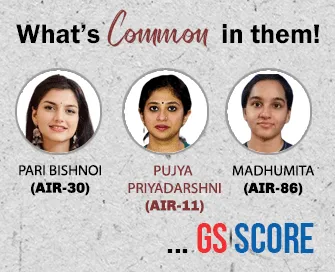
Mains Issues
Context
The Digital Personal Data Protection (DPDP) Act, 2023 has been passed, and the Draft DPDP Rules, 2025 have been released, introducing a framework for Consent Managers (CMs). This has sparked discussions on leveraging the existing Account Aggregator (AA) model as a blueprint for rolling out consent-based data governance across sectors beyond finance.
Background (India’s Data Governance Landscape)
- India is moving towards a more structured, privacy-respecting, and user-empowering data ecosystem. This effort is driven by:
- The Digital Personal Data Protection (DPDP) Act, 2023: India’s landmark privacy law which gives individuals (called Data Principals) greater control over their personal data.
- The Account Aggregator (AA) framework: A practical model already working in India’s financial sector that enables individuals to share their financial data securely, based on explicit consent.
- As India rolls out the DPDP Act, Consent Managers (CMs) are being proposed as key players to ensure that people have full control over who uses their personal data and for what purpose. The AA model is seen as a blueprint for this broader regime.
What are Account Aggregators (AAs)?
- Account Aggregators are digital platforms licensed by the RBI that allow individuals to:
- View, manage, and share their financial data (like bank statements, insurance, tax info) from multiple sources.
- Share this data securely with other institutions like lenders or investment platforms – only if they give consent.
- Revoke consent any time they want.
- This system does not store data – it simply acts as a secure bridge between the data holder (like your bank) and the data receiver (like a loan provider), based on user consent.
- Significance:
- It breaks data silos across banks, mutual funds, and insurers.
- It makes financial services faster and more tailored.
- Most importantly, you remain in charge of your data.
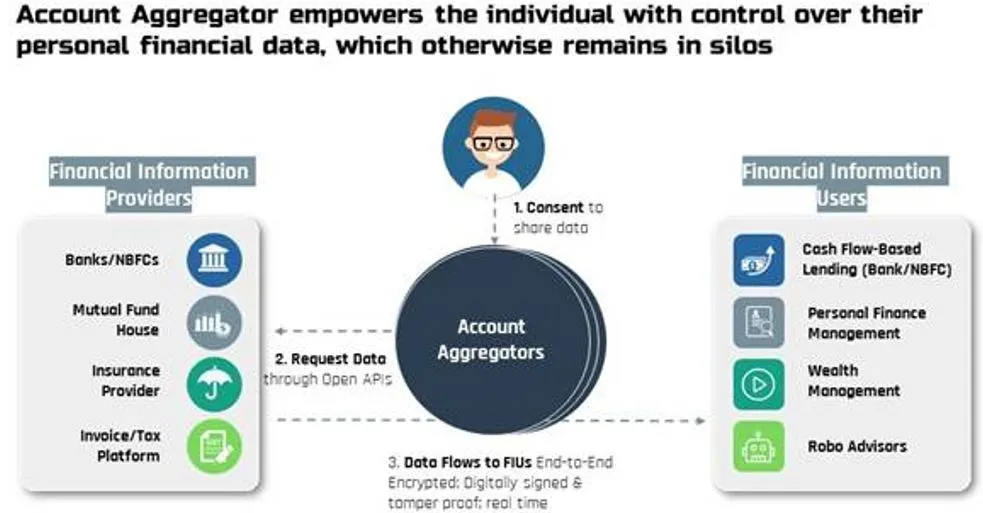
What is the DPDP Act, and what are Consent Managers?
- The DPDP Act, 2023 aims to create a rights-based framework where:
- Data can be collected or processed only after the user consents.
- Consent must be free, informed, specific, and revocable.
- Users must be able to manage and withdraw this consent easily.
- This is where Consent Managers come in.
- Under the DPDP regime:
- A Consent Manager is an intermediary who helps individuals give, manage, and withdraw consent from multiple organisations (called Data Fiduciaries).
- They act as user-friendly dashboards that work across sectors – not just finance, but also healthcare, education, employment, e-commerce, etc.
- This mirrors the AA model but on a wider, all-sector scale.
Why the AA Model is the Blueprint?
- The AA framework already works at scale in finance and has:
- A strong legal foundation (via RBI’s Master Directions).
- Real-time, machine-readable, API-based consent flows.
- A focus on user control, privacy, and data minimisation.
- Given this experience, it makes sense to use it as the base model for Consent Managers under the DPDP Act. This would help India avoid starting from scratch and create one interoperable, unified framework for all personal data.
Key Proposals & Needed Reforms
- Mandatory Registration with the Data Protection Board (DPB): All Consent Managers should be officially registered to ensure accountability and legal compliance.
- Allow Sector-Specific Consent Managers
- Let different sectors (health, education, etc.) have their own consent managers, as long as they follow common technical standards.
- Enable Commercial Sustainability: Consent Managers should be allowed to form legitimate business arrangements with Data Fiduciaries (like banks, hospitals, etc.), provided they don’t compromise user rights.
Wider Significance and Challenges
|
Benefits: |
Challenges: |
|
|


Mains Issues
Context
In a historic anti-Naxal operation at Karreguttalu Hill on the Chhattisgarh-Telangana border, security forces eliminated 31 Naxalites in the largest such operation to date, marking a major step towards the government's goal of making India Naxal-free by March 31, 2026.
What is Naxalism?
- Naxalism refers to the violent armed struggle led by communist extremist groups, inspired by Maoist ideology, to overthrow the Indian state through people’s war.
- It originated in 1967 from a peasant uprising in Naxalbari village in West Bengal — hence the name "Naxalism."
- These groups, often called Left-Wing Extremists (LWE), claim to represent the marginalized, especially tribals, Dalits, and landless peasants, and aim to establish a communist state through armed revolution.
- Factors Responsible for the Rise of Naxalism
- Economic and Social Deprivation
- Land and Forest Rights Issues
- Weak Governance and Security Vacuum
- Political Neglect and Corruption
- Ideological Indoctrination
- Key Areas Affected: Naxalism is concentrated in the “Red Corridor”, spanning central and eastern India:
- Chhattisgarh (especially Bastar, Sukma, Bijapur, Narayanpur), Jharkhand, Odisha, Maharashtra (Gadchiroli), Telangana, Andhra Pradesh, Bihar, West Bengal (Junglemahal area)
- At its peak, over 200 districts were considered Naxal-affected. By 2025, this has reduced to 18 districts.
Government's Initiatives to End Naxalism
- Security Measures
- Joint Operations: Operation Prahar (2017), Operation Green Hunt, Operation Hill Vijay, Operation Samadhan-Prahar, and Operation Thunder
- SAMADHAN Doctrine: It is a strategy combining Security, Development, and Confidence-building.
- Establishment of Security Camps: In inaccessible areas.
- Modernization of Police Forces: Better arms, communication, and intelligence.
- Developmental Interventions
- Aspirational Districts Programme: Focused development in backward regions.
- Infrastructure Projects: Roads, telecom, schools, health centers.
- Skill Development & Employment: Particularly for tribal youth.
- Administrative & Legal Measures
- Unified Command Structures for joint planning.
- National Policy and Action Plan (2015) to combat LWE holistically.
- Creation of Fortified Police Stations and Night-landing helipads.
PYQQ. Naxalism is a social, economic and development issues manifesting as a violent internal security threat. In this context, discuss the emerging issues and suggest a multilayered strategy to tackle the menace of Naxalism. (2022) |


Prelims Articles
Context
The 12-day Saraswati Pushkaralu, a once-in-12-year mega religious festival dedicated to the mythical Saraswati river, began at Kaleshwaram in Telangana. This is the first time the event is being officially organized by the Telangana government since the state's formation in 2014.
About Saraswati Pushkaralu
- Saraswati Pushkaralu is a once-in-12-years Hindu religious festival dedicated to the mythical Saraswati river, believed to be a subterranean (underground) river in Indian tradition.
- It is a river festival similar to the Kumbh Mela, observed when Jupiter (Guru) enters the zodiac sign associated with the river—in this case, Gemini (Mithuna Rasi) for Saraswati.
- The festival lasts for 12 days from the time of Jupiter’s entry into the specific zodiac sign.
- It is celebrated mainly at Triveni Sangamam in Kaleshwaram, Telangana, where the Godavari, Pranahita, and Saraswati rivers are believed to converge.
- Belief: Taking a holy dip during this period is believed to purify sins and bestow spiritual merit.
- Cultural Importance: Saraswati Pushkaralu blends astronomical belief, ritual purity, and river worship, underscoring the deep reverence for rivers in Indian civilization.


Prelims Articles
Context
A new study by the National Institute of Oceanography found that Karnataka's plan to divert water from the Mahadayi river will have minimal impact on Goa’s Mandovi estuary. This has brought the long-standing water dispute between Karnataka and Goa back into focus.
About the Mahadayi (Mhadei) River
- River Mahadayi is spread across the Districts of Goa, Karnataka and Maharashtra.
- Origin: The Mahadayi River originates in the Western Ghats in Karnataka’s Belagavi district (Bhimgad Wildlife Sanctuary).
- Length: Approximately 111 km long.
- Drainage Basin: It covers around 2032 sq. km, with 52 km in Karnataka, 9 km in Maharashtra, and the remaining 50 km in Goa.
- Flow: It flows westward and drains into the Arabian Sea at Panaji (Goa), where it is known as the Mandovi River.
- Tributaries: Kalasa Nala, Surla Nala, Haltar Nala, Poti Nala, Mahadayi Nala, Pansheer Nala, Bail Nala, Andher Nala
- Importance:
- For Goa: It is lifeline for drinking water, agriculture, navigation, and ecological sustainability. The river supports the Mandovi estuary, which is crucial for Goa’s economy.
- For Karnataka: It is seen as a potential source to augment water supply to Malaprabha basin, which caters to drought-prone districts like Dharwad, Gadag, and Belagavi.
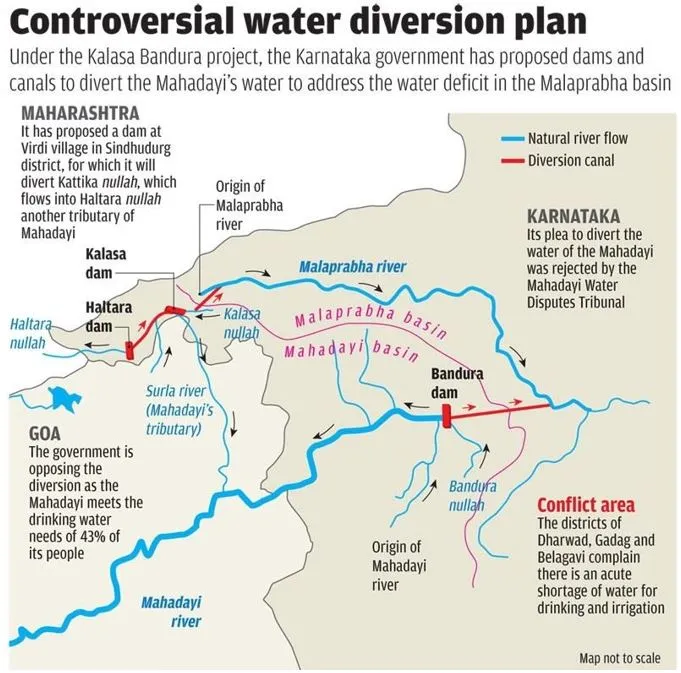
The Dispute
- States Involved: Goa (downstream), Karnataka (upstream), and Maharashtra (minor stakeholder).
- Issue: Karnataka wants to divert water from two Mahadayi tributaries — Kalasa and Bhandura (Bandura) — to the east-flowing Malaprabha River, a tributary of the Krishna.
- Goa's Opposition:
- Goa claims this diversion will reduce river flow, particularly in dry seasons, and threaten its drinking water needs, Mandovi estuary ecosystem, and the Mhadei Wildlife Sanctuary.
- Also raises concerns of ecological degradation and violation of inter-state water sharing principles.
Mahadayi Water Disputes Tribunal (MWDT)
|

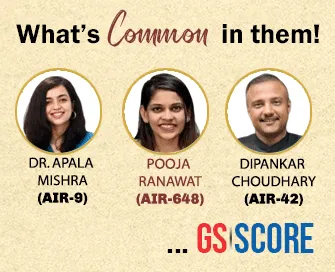
Prelims Articles
Context
China has repeatedly tried to assert its claim over Arunachal Pradesh by renaming locations and calling it "Zangnan" (South Tibet), but India has firmly rejected these moves, affirming the state as an integral part of its territory.
What is China doing?
- China has followed a pattern of issuing “standardised names” for places in Arunachal Pradesh, claiming them as part of its territory. This is not new, but has gained momentum in recent years:
- 1st List (2017): 6 locations renamed
Key-locations |
|
|
Chinese Name |
Likely Indian Location (District) |
|
Wo’gyainling |
Tawang |
|
Mila Ri |
Kra Daadi |
|
Qoidengarbo Ri |
West Siang |
|
Mainquka |
Siang (Mechuka/Menchuka) |
|
Bumo La |
Anjaw |
|
Namkapub Ri |
Subansiri |
- 2nd List (2021): 15 locations renamed
- 3rd List (2023): 11 locations renamed
- 4th List (2024): 30 locations renamed
- These names are published under the “regulations on geographical names” by the Chinese government and are meant to build a formal narrative in official documents, maps, and international communication.
- Key-locations being renamed by China
- The places renamed generally include mountain peaks, rivers, residential areas, and passes across Tawang, Upper Subansiri, Siang, and other sensitive districts of Arunachal Pradesh.
- These areas are not random — they are mostly close to the Line of Actual Control (LAC)
- Strategically important, especially near Tawang, which China considers particularly sensitive
- Locations linked with local cultural, historical, or religious value to India (e.g., Tawang is associated with Tibetan Buddhism and the Dalai Lama’s journey)
- These renamings span across Arunachal Pradesh, from Tawang in the west to Anjaw in the east, covering key districts like Siang, West Siang, Subansiri, and Kra Daadi.
- The Chinese government has standardised the names of some parts of Zangnan. This is within China’s sovereign rights. Zangnan is the Chinese name for Arunachal Pradesh. China claims some 90,000 sq km of Arunachal Pradesh as its territory.
Significance of Arunachal Pradesh
- Strategic Geography: Arunachal borders Tibet (China), Bhutan, and Myanmar — making it crucial for India's eastern defence.
- Tawang and Buddhism: Tawang, the westernmost part of Arunachal Pradesh, is bounded by Tibet (China) to the north, Bhutan to the southwest and Sela ranges separated from West Kament district in the east.
- The inhabitants of this district are all of the Monpa tribe. The Monpa belongs to the Mongoloid stock.
- Tawang is spiritually significant as the birthplace of the 6th Dalai Lama and was part of historical Tibetan trade routes. China considers it symbolically important, fearing any future developments involving the Dalai Lama's succession.
- Buffer Zone: Like Aksai Chin in Ladakh, China views border regions as buffers for security. Arunachal, from Beijing’s point of view, would be a flank if tensions rise in Tibet.
India-China border:
|


Prelims Articles
Context
The government appointed former defence secretary Dr Ajay Kumar as the chairman of the Union Public Service Commission (UPSC), filling the vacancy caused by former chairperson Preeti Sudan’s retirement.
About
- The UPSC is responsible for conducting civil services exams, which are used to select officers for top services like the IAS (Indian Administrative Service), IFS (Indian Foreign Service), and IPS (Indian Police Service). The commission is headed by a chairman and can have up to 10 members.
- The Constitution of India provides for four watchdogs to keep a check on different functions of the State.
- The Supreme Court: SC keeps a check on the judicial functions of the state.
- The Election Commission of India: ECI ensures free and fair elections.
- The Comptroller and Auditor General of India: The Comptroller and Auditor General keep in check the finances of the country.
- The Union Public Service Commission: UPSC is a watchdog to ensure fair recruitment on the basis of merit.
- The Constitution visualises the UPSC to be the ‘watch-dog of merit system’ in India.
- Constitutional Provisions: Article 315 to 323 of Part XIV of the Indian Constitution deals with provisions relating to the Union Public Service Commission as well as the State Public Service Commission.
- UPSC Chairman
- The Chairman of the Union Public Service Commission (UPSC) is appointed by the President of India.
- The term of appointment is regulated in accordance with the provisions of Article 316(2) of the Constitution of India, and the conditions of service will be governed by UPSC (Members) Regulations, 1969, as amended from time to time.
- Tenure: He/she holds office for a term of six years or until attaining the age of 65 years, whichever is earlier.
- Re-appointment: A person who has once held office as a member (including Chairman) of a Public Service Commission is not eligible for reappointment to that office.
- Resignation: The Chairman may resign by writing to the President of India.
- Removal and Suspension: The Chairman can be removed from office by the President only in specific conditions as provided under the Constitution. The President may suspend the Chairman while a reference is made to the Supreme Court regarding the grounds of removal.
- Grounds for removal include:
- Insolvency (bankruptcy).
- Engaging in paid employment outside the duties of the office.
- Being physically or mentally unfit, as determined by the President.
- Conditions of Service: The President determines the conditions of service of the Chairman and other members at the time of appointment. Conditions cannot be altered to their disadvantage after the appointment.
- Remuneration and Expenses: The salary, allowances, and pension of the Chairman are paid from the Consolidated Fund of India.


Prelims Articles
Context
China and Colombia signed a joint cooperation plan under the Belt and Road Initiative (BRI).
What is the Belt and Road Initiative (BRI)?
- Launched in: 2013
- The Belt and Road Initiative (BRI) is China’s flagship global infrastructure and economic development project.
- It aims to enhance connectivity and economic integration across Asia, Africa, Europe, and Latin America by:
- Building roads, railways, ports, pipelines, and power plants.
- Boosting trade and investment flows.
- Encouraging people-to-people ties and tourism.
- Creating global supply chain links centered on China.
- The idea is inspired by the ancient Silk Road trade routes, hence the name.
- Participation:
- As of now, over 150 countries and 30+ international organizations have signed cooperation agreements under BRI. These include both developing and developed nations across continents.
- After Colombia’s entry, the number of Latin American and Caribbean countries participating in BRI has risen to over 20.
- India’s stand on the initiative: India is one of the countries who has concerns about the Belt and Road Initiative. This is especially in the context of the disputed borders it shares with China and the China-PakistanEconomic Corridor (CPEC) which runs through Pakistan Occupied Kashmir (POK).


Prelims Articles
Context
The Akash missile system played a key role in thwarting Pakistan’s aerial attacks during Operation Sindoor, highlighting its operational effectiveness and indigenisation success.
About Akash Missile System:
- Akash is a mobile short-to-medium-range Surface-to Air Missile system (SAM).
- It was developed as part of the Integrated Guided Missile Development Programme (IGMDP) started in the 1980s.
- Developer: DRDO, under the Integrated Guided Missile Development Programme (IGMDP).
- Users: It is currently in service with the Indian Air Force (IAF) and the Indian Army.
- Induction: IAF (2014), Army (2015).
- It is designed to provide air defence cover to the vulnerable areas and critical installations.
- The system can simultaneously engage multiple aerial targets such as enemy aircraft, missiles, and unmanned aerial vehicles (UAVs).
- Key Features of Akash:
- The missile can intercept and destroy multiple aerial targets at the same time.
- It has an operational range of around 27 to 30 km and can fly at twice the speed of sound (Mach 2.5).
- It can reach up to 18 km in altitude, making it suitable for high-flying targets.
- The system is mounted on vehicles, which means it can be quickly moved, deployed, or redeployed as needed.
- Indigenous Content: ~96%, produced by over 250 Indian industries (BEL, BDL, etc.).
Working of the Missile System
- A 3D Central Acquisition Radar first scans the sky and detects potential threats within a 120 km radius.
- The Rajendra Radar, which is the fire control radar, then tracks the threat and provides data to the command centre.
- Based on this data, the command and control centre calculates the best path to intercept the target.
- A missile is launched from a mobile launcher, which can carry three missiles.
- Once near the target, an onboard seeker helps the missile precisely strike, even if the target is moving.
- Even without a direct hit, the missile’s proximity fuse can cause damage using its 55 kg warhead, which explodes when close to the target.
New and Improved Variants:Akash Prime
Akash-NG (New Generation)
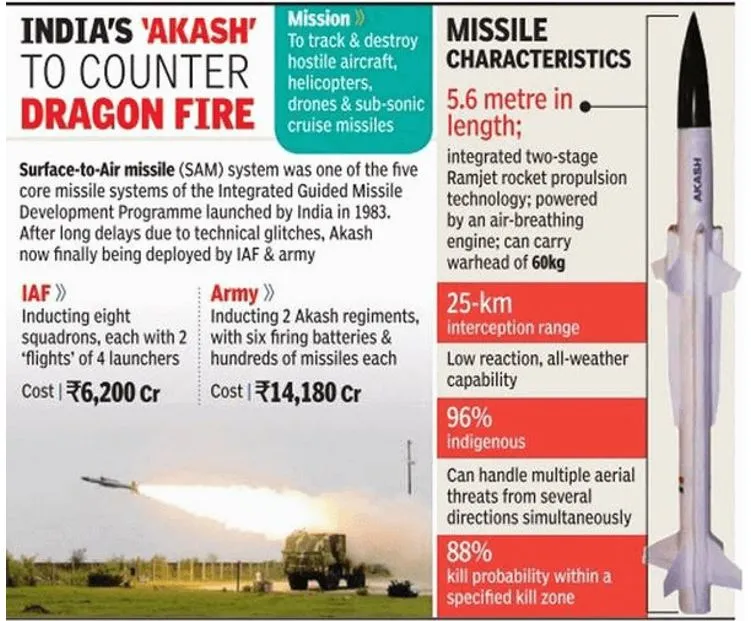 |


Editorials
Context
Ahmed al-Sharaa (formerly Abu Mohammad al-Jolani), ex-leader of al-Qaeda’s Syrian affiliate Jabhat al-Nusra and current head of Hayat Tahrir al-Sham (HTS), met U.S. President Donald Trump in Riyadh following HTS’s December 2024 capture of Damascus. This signals growing international legitimacy for his Islamist regime after decades of conflict in Syria.
Political Transformation and International Legitimacy:
- From Terrorist to Statesman: Ahmed al-Sharaa, once a U.S.-designated global terrorist, now heads Syria after HTS ousted Bashar al-Assad; he recently held meetings with world leaders including Trump, Macron, and Qatar’s Emir.
- Collapse of Assad Regime: HTS seized Damascus in December 2024, ending Assad’s long-standing secular dictatorship and paving the way for an Islamist-dominated administration under Sharaa.
- Geopolitical Backing: Türkiye and Gulf powers, including Saudi Arabia, have extended support to the new Syrian regime, positioning it as a legitimate player in regional diplomacy.
Economic Prospects and Reconstruction Potential:
- Lifting of U.S. Sanctions: On the sidelines of the Riyadh summit, President Trump ended decades-long U.S. sanctions on Syria, enabling potential inflow of foreign capital.
- Energy and Investment Outreach: Sharaa has invited U.S. firms to invest in Syria’s oil and gas sectors, aiming to rebuild the economy through international corporate partnerships.
- Arab Reconstruction Capital: Wealthy monarchies in the Gulf are expected to fund Syria’s war recovery and reconstruction, with business interests in infrastructure and energy.
Internal Instability and Governance Challenges:
- Sectarian Targeted Violence: After HTS’s rise, Syria has witnessed multiple atrocities against Alawites, Druze, and Kurds — including massacres in Latakia and attacks in central Syria.
- Opposition to Centralisation: Kurds in northeastern Syria demand decentralised democracy, rejecting HTS’s authoritarian governance and fearing marginalisation.
- Need for Inclusive Constitution: To prevent state collapse, Sharaa must dismantle armed factions and adopt a constitution that ensures rights for all ethnic and religious groups.
Practice Question:
Q. Syria’s recent political shift under Ahmed al-Sharaa reflects the paradox of transitioning from militant dominance to international legitimacy. In this context, critically examine the role of regional geopolitics, economic incentives, and internal social cohesion in determining the success of post-conflict reconstruction in fragile states.

Editorials
Context
Following the recent India-Pakistan ceasefire agreement, U.S. President Donald Trump publicly claimed the U.S. had mediated the deal, sparking controversy. India quickly dismissed the suggestion, reiterating that the Kashmir issue remains a strictly bilateral matter and reaffirming its stance against third-party involvement.
US Position and Trump's Claims:
- Premature Ceasefire Announcement: Trump pre-emptively declared the India-Pakistan ceasefire on social media before official confirmation from either country, attempting to project U.S. influence.
- Leverage through Trade: He hinted that “trade pressure” was used to influence both India and Pakistan, implying a coercive role of economic tools in achieving diplomatic outcomes.
- Mediation Walkback: Despite Trump’s assertions, the U.S. State Department later clarified it had no active mediation role, urging India and Pakistan to maintain direct bilateral communication.
India’s Firm Bilateral Approach:
- Rejection of Mediation: India categorically denied any third-party involvement, publishing a timeline proving Pakistan initiated the de-escalation talks and reasserting the bilateral framework of the Kashmir issue.
- Focus on Terror and PoK: India clarified that the only dialogue subjects with Pakistan are cross-border terrorism and Pakistan’s illegal occupation of parts of Jammu and Kashmir.
- Defiance of Nuclear Blackmail: India made it clear that it won’t succumb to nuclear coercion and would maintain strategic restraint while safeguarding national sovereignty.
Evolving Geopolitics and Indian Diplomacy:
- Trump-Era Instability: Trump’s erratic foreign policy — ranging from Syria sanctions to Ukraine stance shifts — has disrupted traditional diplomacy, but India has adapted with resilience.
- India’s Enhanced Global Standing: Over decades, especially post-liberalisation, India has outpaced Pakistan economically and gained greater international clout, reducing the global appetite for Kashmir mediation.
- Diplomatic Strategy Going Forward: While India continues to strengthen ties with the U.S., it must tactfully manage political optics, ensuring consistent messaging against internationalisation of internal issues.
Practice Question:
Q. Critically analyse India’s approach to external involvement in the Kashmir issue, with reference to historical developments and recent geopolitical claims of mediation. How should India balance bilateral principles with strategic global diplomacy in such scenarios?

Editorials
Context
The ethnic conflict in Manipur has completed two years (May 2023–2025) with over 250 lives lost, thousands internally displaced, and continuing lawlessness. Despite this humanitarian and political crisis, no significant national attention or effective resolution framework has emerged from the Union government, highlighting a paradox in New Delhi's selective security engagement with border states.
Centre’s Neglect and Contradictory Political Priorities
- Uneven Response to Internal Conflicts: While Prime Minister Modi reacted swiftly to the April 2024 Pahalgam terror attack, the prolonged ethnic crisis in Manipur has not elicited any direct intervention or visit, reflecting a lack of prioritisation despite the scale of internal displacement and deaths.
- Security Optics Over Political Will: The Centre continues to ignore the core political issues in Manipur and instead pushes symbolic actions such as arms surrender ceremonies that serve optical political gains rather than address root causes.
- Stark Policy Contrast with Kashmir: Unlike Kashmir, which is perceived as central to India's national security matrix, Manipur’s crisis is dismissed as an internal disturbance, despite historical cross-border linkages with armed groups once backed by China and Pakistan.
Misplaced Security Focus and Ethnic Majoritarianism
- Ethnic Framing of Security Threats: The blame has been shifted disproportionately to alleged cross-border Kuki militants, while ignoring the mobilisation of valley-based insurgent groups (VBIGs) like Arambai Tenggol, effectively allowing them to fill the security vacuum.
- Buffer Zone Militarisation and State Failure: A ‘buffer zone’ demarcating Meitei and Kuki-Zomi-Hmar areas has outsourced law and order to armed vigilante groups, under the pretext of security while the state fails to protect vulnerable populations.
- Operational Reversal Post Operation All Clear (2004): The resurgence of VBIGs undermines gains from the 2004 Operation All Clear, revealing a failure to modernise security infrastructure, improve intelligence capacity, and enforce law and order objectively.
Flawed Border Policy and Incomplete Disarmament
- Obsolete Border Security Vision: The Rs 31,000 crore India–Myanmar border fencing project—especially along the 398-km Manipur-Myanmar stretch—is driven more by political optics and economic vested interests than by evidence-based security strategy. It alienates transborder ethnic communities (Nagas, Mizos), undermining the Act East Policy.
- Ineffective Arms Surrender Mechanism: Out of 6,020 arms looted, only around 4,000 have been returned; the spectacle of 246 country-made weapons surrendered by Arambai Tenggol days before a government deadline highlights superficial disarmament efforts with no real accountability.
- Delayed Central Intervention and its Messaging: The imposition of President’s Rule in February 2025, was less a solution and more a damage-control measure, indicating to armed groups that unchecked violence would no longer be tolerated, albeit without any clear reconciliation plan.
Practice Question
Q. The ongoing Manipur crisis reflects a deeper failure of India’s internal security strategy and centre-state political engagement in ethnically sensitive regions. Critically analyse this statement in light of the Centre’s response to the conflict. What structural reforms are required to prevent recurrence of such state failures?

